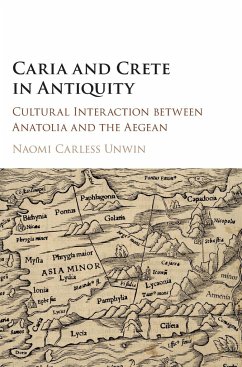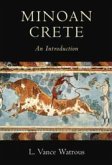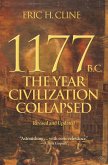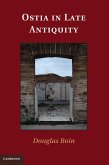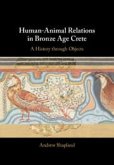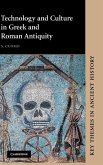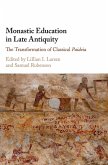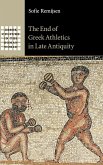Naomi Carless Unwin
Caria and Crete in Antiquity
90,99 €
inkl. MwSt.
**Unverbindliche Preisempfehlung des Herstellers
Versandkostenfrei*Versandfertig in 1-2 Wochen

45 °P sammeln
Naomi Carless Unwin
Caria and Crete in Antiquity
- Gebundenes Buch
- Merkliste
- Auf die Merkliste
- Bewerten Bewerten
- Teilen
- Produkt teilen
- Produkterinnerung
- Produkterinnerung
Examines what regional mythologies reveal about the social and cultural orientation and identity of Caria in antiquity.
Andere Kunden interessierten sich auch für
![Minoan Crete Minoan Crete]() L Vance WatrousMinoan Crete116,99 €
L Vance WatrousMinoan Crete116,99 €![1177 B.C. 1177 B.C.]() Eric Cline1177 B.C.14,99 €
Eric Cline1177 B.C.14,99 €![Ostia in Late Antiquity Ostia in Late Antiquity]() Douglas BoinOstia in Late Antiquity97,99 €
Douglas BoinOstia in Late Antiquity97,99 €![Human-Animal Relations in Bronze Age Crete Human-Animal Relations in Bronze Age Crete]() Andrew ShaplandHuman-Animal Relations in Bronze Age Crete96,99 €
Andrew ShaplandHuman-Animal Relations in Bronze Age Crete96,99 €![Technology and Culture in Greek and Roman Antiquity Technology and Culture in Greek and Roman Antiquity]() S. CuomoTechnology and Culture in Greek and Roman Antiquity95,99 €
S. CuomoTechnology and Culture in Greek and Roman Antiquity95,99 €![Monastic Education in Late Antiquity Monastic Education in Late Antiquity]() Monastic Education in Late Antiquity110,99 €
Monastic Education in Late Antiquity110,99 €![The End of Greek Athletics in Late Antiquity The End of Greek Athletics in Late Antiquity]() Sofie RemijsenThe End of Greek Athletics in Late Antiquity120,99 €
Sofie RemijsenThe End of Greek Athletics in Late Antiquity120,99 €-
-
-
Examines what regional mythologies reveal about the social and cultural orientation and identity of Caria in antiquity.
Hinweis: Dieser Artikel kann nur an eine deutsche Lieferadresse ausgeliefert werden.
Hinweis: Dieser Artikel kann nur an eine deutsche Lieferadresse ausgeliefert werden.
Produktdetails
- Produktdetails
- Verlag: Cambridge University Press
- Seitenzahl: 288
- Erscheinungstermin: 13. Juli 2017
- Englisch
- Abmessung: 250mm x 175mm x 20mm
- Gewicht: 680g
- ISBN-13: 9781107194175
- ISBN-10: 1107194172
- Artikelnr.: 49087383
- Herstellerkennzeichnung
- Libri GmbH
- Europaallee 1
- 36244 Bad Hersfeld
- gpsr@libri.de
- Verlag: Cambridge University Press
- Seitenzahl: 288
- Erscheinungstermin: 13. Juli 2017
- Englisch
- Abmessung: 250mm x 175mm x 20mm
- Gewicht: 680g
- ISBN-13: 9781107194175
- ISBN-10: 1107194172
- Artikelnr.: 49087383
- Herstellerkennzeichnung
- Libri GmbH
- Europaallee 1
- 36244 Bad Hersfeld
- gpsr@libri.de
Naomi Carless Unwin is a Research Fellow at the Center for Hellenic Studies at Harvard University. She has been involved for many years in the archaeological excavations at the sanctuary of Labraunda in Caria, focusing particularly on the epigraphy of the site.
Introduction. Approaching the topic of Carian-Cretan interaction
The Carian-Cretan connection
Caria and Crete in the maritime itineraries of the Mediterranean
The Labrys and the labyrinth
Network formation and cultural exchange
Approaching Carian-Cretan interaction
1. Articulating a 'Carian' identity
'The Carians of barbarian speech'
Language and identity
Delimiting 'Caria' and the 'Carians'
2. The role of Crete in the mythologies, local histories and cults of Caria
Ancient engagement with the past
Sarpedon, Miletos and Kaunos
The 'Minoan' ports of Anatolia
The Kr¿tinaion of Magnesia-on-the-Maeander
The Carian Kouretes
Reading mythological traditions
3. The case of Miletos: archaeology and mythology
The processes of transmission and the question of origins
Late Bronze Age Miletos
Minoan and Mycenaean contacts with Southwestern Anatolia
Western Anatolia in the Hittite sources
Caria on the interface
Miletos: continuities and innovation
4. Interaction and the reception of the Cretan connection during the hellenistic period
Tracing interaction between Caria and Crete
The Cretan decrees from Mylasa
Cretan diplomacy and Cretan piracy
Contextualising the Mylasan inscriptions
The role of the past in diplomatic discourse
5. Inscribing history at Magnesia- on- the- Maeander: Civic engagement with the past
Inscribing history
The civic context of the 'origin myth'
Shaping the past
6. A 'Cretan- Born' Zeus in Caria: Religious mobility between Caria and Crete
The evidence
Dynastic influence vs. local dynamics
The constitutional reforms at Euromos
Interaction and religious mobility
Interpreting the Carian cults of Zeus Kretagenes/ Kretagenetas
Concluding remarks
Appendix 1. I. Magnesia 17
Appendix 2. The 'Cretan Dossier' of Mylasa
References
Index.
The Carian-Cretan connection
Caria and Crete in the maritime itineraries of the Mediterranean
The Labrys and the labyrinth
Network formation and cultural exchange
Approaching Carian-Cretan interaction
1. Articulating a 'Carian' identity
'The Carians of barbarian speech'
Language and identity
Delimiting 'Caria' and the 'Carians'
2. The role of Crete in the mythologies, local histories and cults of Caria
Ancient engagement with the past
Sarpedon, Miletos and Kaunos
The 'Minoan' ports of Anatolia
The Kr¿tinaion of Magnesia-on-the-Maeander
The Carian Kouretes
Reading mythological traditions
3. The case of Miletos: archaeology and mythology
The processes of transmission and the question of origins
Late Bronze Age Miletos
Minoan and Mycenaean contacts with Southwestern Anatolia
Western Anatolia in the Hittite sources
Caria on the interface
Miletos: continuities and innovation
4. Interaction and the reception of the Cretan connection during the hellenistic period
Tracing interaction between Caria and Crete
The Cretan decrees from Mylasa
Cretan diplomacy and Cretan piracy
Contextualising the Mylasan inscriptions
The role of the past in diplomatic discourse
5. Inscribing history at Magnesia- on- the- Maeander: Civic engagement with the past
Inscribing history
The civic context of the 'origin myth'
Shaping the past
6. A 'Cretan- Born' Zeus in Caria: Religious mobility between Caria and Crete
The evidence
Dynastic influence vs. local dynamics
The constitutional reforms at Euromos
Interaction and religious mobility
Interpreting the Carian cults of Zeus Kretagenes/ Kretagenetas
Concluding remarks
Appendix 1. I. Magnesia 17
Appendix 2. The 'Cretan Dossier' of Mylasa
References
Index.
Introduction. Approaching the topic of Carian-Cretan interaction
The Carian-Cretan connection
Caria and Crete in the maritime itineraries of the Mediterranean
The Labrys and the labyrinth
Network formation and cultural exchange
Approaching Carian-Cretan interaction
1. Articulating a 'Carian' identity
'The Carians of barbarian speech'
Language and identity
Delimiting 'Caria' and the 'Carians'
2. The role of Crete in the mythologies, local histories and cults of Caria
Ancient engagement with the past
Sarpedon, Miletos and Kaunos
The 'Minoan' ports of Anatolia
The Kr¿tinaion of Magnesia-on-the-Maeander
The Carian Kouretes
Reading mythological traditions
3. The case of Miletos: archaeology and mythology
The processes of transmission and the question of origins
Late Bronze Age Miletos
Minoan and Mycenaean contacts with Southwestern Anatolia
Western Anatolia in the Hittite sources
Caria on the interface
Miletos: continuities and innovation
4. Interaction and the reception of the Cretan connection during the hellenistic period
Tracing interaction between Caria and Crete
The Cretan decrees from Mylasa
Cretan diplomacy and Cretan piracy
Contextualising the Mylasan inscriptions
The role of the past in diplomatic discourse
5. Inscribing history at Magnesia- on- the- Maeander: Civic engagement with the past
Inscribing history
The civic context of the 'origin myth'
Shaping the past
6. A 'Cretan- Born' Zeus in Caria: Religious mobility between Caria and Crete
The evidence
Dynastic influence vs. local dynamics
The constitutional reforms at Euromos
Interaction and religious mobility
Interpreting the Carian cults of Zeus Kretagenes/ Kretagenetas
Concluding remarks
Appendix 1. I. Magnesia 17
Appendix 2. The 'Cretan Dossier' of Mylasa
References
Index.
The Carian-Cretan connection
Caria and Crete in the maritime itineraries of the Mediterranean
The Labrys and the labyrinth
Network formation and cultural exchange
Approaching Carian-Cretan interaction
1. Articulating a 'Carian' identity
'The Carians of barbarian speech'
Language and identity
Delimiting 'Caria' and the 'Carians'
2. The role of Crete in the mythologies, local histories and cults of Caria
Ancient engagement with the past
Sarpedon, Miletos and Kaunos
The 'Minoan' ports of Anatolia
The Kr¿tinaion of Magnesia-on-the-Maeander
The Carian Kouretes
Reading mythological traditions
3. The case of Miletos: archaeology and mythology
The processes of transmission and the question of origins
Late Bronze Age Miletos
Minoan and Mycenaean contacts with Southwestern Anatolia
Western Anatolia in the Hittite sources
Caria on the interface
Miletos: continuities and innovation
4. Interaction and the reception of the Cretan connection during the hellenistic period
Tracing interaction between Caria and Crete
The Cretan decrees from Mylasa
Cretan diplomacy and Cretan piracy
Contextualising the Mylasan inscriptions
The role of the past in diplomatic discourse
5. Inscribing history at Magnesia- on- the- Maeander: Civic engagement with the past
Inscribing history
The civic context of the 'origin myth'
Shaping the past
6. A 'Cretan- Born' Zeus in Caria: Religious mobility between Caria and Crete
The evidence
Dynastic influence vs. local dynamics
The constitutional reforms at Euromos
Interaction and religious mobility
Interpreting the Carian cults of Zeus Kretagenes/ Kretagenetas
Concluding remarks
Appendix 1. I. Magnesia 17
Appendix 2. The 'Cretan Dossier' of Mylasa
References
Index.
